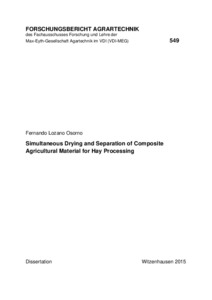| dc.date.accessioned | 2015-10-14T07:37:50Z | |
| dc.date.available | 2015-10-14T07:37:50Z | |
| dc.date.issued | 2015-10-14 | |
| dc.identifier.uri | urn:nbn:de:hebis:34-2015101449129 | |
| dc.identifier.uri | http://hdl.handle.net/123456789/2015101449129 | |
| dc.description.sponsorship | Universidad Nacional de Colombia, Deutscher Akademischer Austauschdienst. Universität Kassel. | ger |
| dc.language.iso | eng | |
| dc.rights | Urheberrechtlich geschützt | |
| dc.rights.uri | https://rightsstatements.org/page/InC/1.0/ | |
| dc.subject | Grass drying | eng |
| dc.subject | Rotary drum dryer | eng |
| dc.subject | CFD | eng |
| dc.subject.ddc | 630 | |
| dc.title | Simultaneous Drying and Separation of Composite Agricultural Material for Hay Processing | eng |
| dc.type | Dissertation | |
| dcterms.abstract | In composite agricultural materials such as grass, tee, medicinal plants; leaves and stems have a different drying time. By this behavior, after leaving the dryer, the stems may have greater moisture content than desired, while the leaves one minor, which can cause either the appearance of fungi or the collapse of the over-dried material.
Taking into account that a lot of grass is dehydrated in forced air dryers, especially rotary drum dryers, this research was developed in order to establish conditions enabling to make a separation of the components during the drying process in order to provide a homogeneous product at the end. For this, a rotary dryer consisting of three concentric cylinders and a circular sieve aligned with the more internal cylinder was proposed; so that, once material enters into the dryer in the area of the inner cylinder, stems pass through sieve to the middle and then continue towards the external cylinder, while the leaves continue by the inner cylinder.
For this project, a mixture of Ryegrass and White Clover was used. The characteristics of the components of a mixture were: Drying Rate in thin layer and in rotation, Bulk density, Projected Area, Terminal velocity, weight/Area Ratio, Flux through Rotary sieve.
Three drying temperatures; 40°C, 60° C and 80° C, and three rotation speeds; 10 rpm, 20 rpm and 40 rpm were evaluated. It was found that the differences in drying time are the less at 80 °C when the dryer rotates at 40 rpm. Above this speed, the material adheres to the walls of the dryer or sieve and does not flow.
According to the measurements of terminal velocity of stems and leaves of the components of the mixture, the speed of the air should be less than 1.5 m s-1 in the inner drum for the leaves and less than 4.5 m s-1 in middle and outer drums for stems, in such way that only the rotational movement of the dryer moves the material and achieves a greater residence time. In other hand, the best rotary sieve separation efficiencies were achieved when the material is dry, but the results are good in all the moisture contents. The best rotary speed of sieve is within the critical rotational speed, i.e. 20 rpm. However, the rotational speed of the dryer, including the sieve in line with the inner cylinder should be 10 rpm or less in order to achieve the greatest residence times of the material inside the dryer and the best agitation through the use of lifting flights.
With a finite element analysis of a dryer prototype, using an air flow allowing speeds of air already stated, I was found that the best performance occurs when, through a cover, air enters the dryer front of the Middle cylinder and when the inner cylinder is formed in its entirety through a sieve. This way, air flows in almost equal amounts by both the middle and external cylinders, while part of the air in the Middle cylinder passes through the sieve towards the inner cylinder. With this, leaves do not adhere to the sieve and flow along drier, thanks to the rotating movement of the drums and the showering caused by the lifting flights.
In these conditions, the differences in drying time are reduced to 60 minutes, but the residence time is higher for the stems than for leaves, therefore the components of the mixture of grass run out of the dryer with the same desired moisture content. | eng |
| dcterms.accessRights | open access | |
| dcterms.creator | Lozano Osorno, Fernando | |
| dcterms.isPartOf | Forschungsbericht Agrartechnik des Fachausschusses Forschung und Lehre der Max-Eyth-Gesellschaft Agrartechnik im VDI (VDI-MEG) ;; 549 | ger |
| dc.contributor.corporatename | Kassel, Universität Kassel, Fachbereich Ökologische Agrarwissenschaften | |
| dc.contributor.referee | Hensel, Oliver (Prof. Dr.) | |
| dc.contributor.referee | Luke, Andrea (Prof. Dr.-Ing. habil.) | |
| dc.subject.ccs | Computational Fluid Dynamics | |
| dc.subject.msc | Computational Fluid Dynamics | ger |
| dc.subject.pacs | Computational Fluid Dynamics | ger |
| dc.subject.swd | Gräser | ger |
| dc.subject.swd | Trocknung | ger |
| dc.subject.swd | Numerische Strömungssimulation | ger |
| dcterms.source.series | Forschungsbericht Agrartechnik des Fachausschusses Forschung und Lehre der Max-Eyth-Gesellschaft Agrartechnik im VDI (VDI-MEG) | ger |
| dcterms.source.volume | 549 | ger |
| dc.date.examination | 2015-07-18 | |

